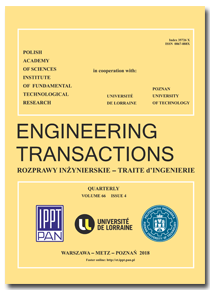10.24423/engtrans.17.2013
Fracture Toughness Investigations of Metal Matrix Composites Using Compact Specimens
References
Dobrzański L., Nowosielski R., Testing of metals and alloys, vol. I, “Investigations of mechanical and physical properties” [in Polish], Silesia University of Technology, Gliwice 1986.
Doga B., Ceyhan U., Nikbin K.M., Petrovski B., Dean D.W., European code of practice of creep crack initiation and growth testing of industrial relevant specimens, Journal of ASTM International, 3, 2, 20, 2006.
Standard Test Method for Plane-Strain Fracture Toughness of Metallic Materials, Annual Book of ASTM Standards, Metals Test Methods and Analytical Procedures, MetalsMechanical Testing: Elevated and Low-Temperature Tests, Metallography, 03.01, 509–539, 1993.
Kalluri S., Telesman J., Characterization of fatigue crack initiation and propagation in Ti-6A1-4V with electrical potential drop technique, NASA Technical Memorandum 100877, July 1988.
Golerthan S., Herberg D., Baruj A., Eggeler G., Compact tension testing of martensitic/pseudoplastic NiTi shape memory alloys, Materials Science Engineering, 481–482, 156–159, 2008.
Bajaj D., Sundaram N., Arola D., Striations resulting from fatigue crack growth in dentin, [in:] Fractography of Glasses and Ceramics V: Ceramic Transactions, James R. Varner, George D. Quinn, Marlene Wightman, 199, 2007.
Dieringa H., Hort N., Kainer K.U., Compression creep of short fibre reinforced magnesium alloy AE42, Composites, 3, 7, 275–278, 2003.
Naplocha K., Kaczmar J.W., Tribological properties of Al 7075 alloy based composites strengthened with Al2O3fibres, Archives of Foundry Engineering, 11, Special Issue 2, 30/2, 153–158, 2011.
http://www.saffil.com/index/fibre home/property information.aspx.
Samuel M., Reinforcement of recycled aluminium-alloy scrap with Saffil ceramic fibres, Journal of Materials Processing Technology, 142, 295–306, 2003.
PN-EN 1676:2011, Aluminium and aluminium alloys – Alloy ingots for remelting – Specifications, 2011.
PN-EN ISO 12737: 2011, Metals – Fracture toughness at biaxial strain state, 2011.
DOI: 10.24423/engtrans.17.2013




